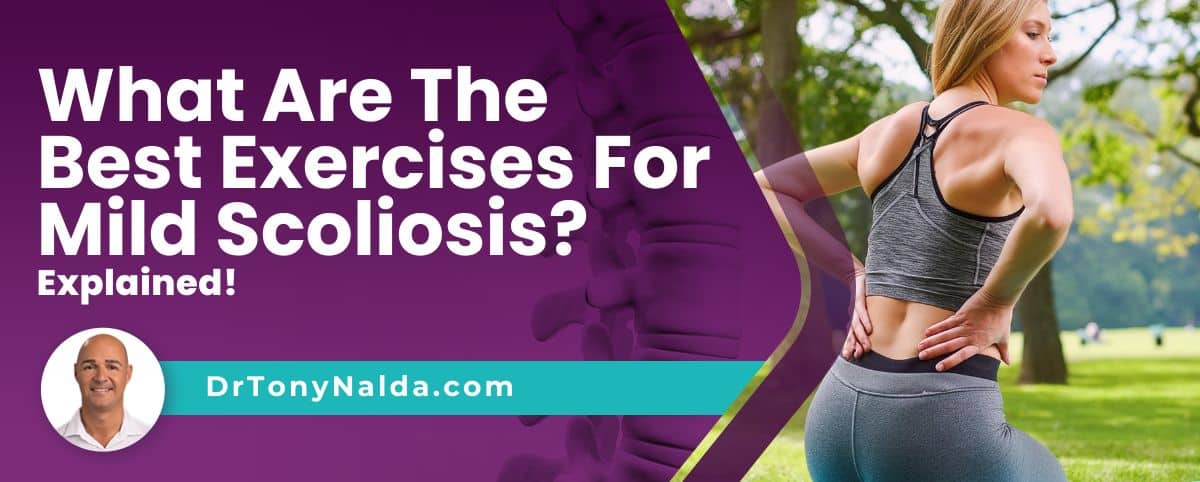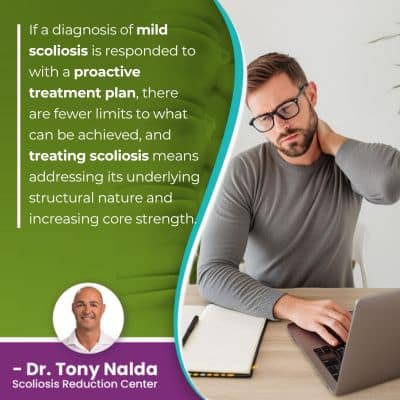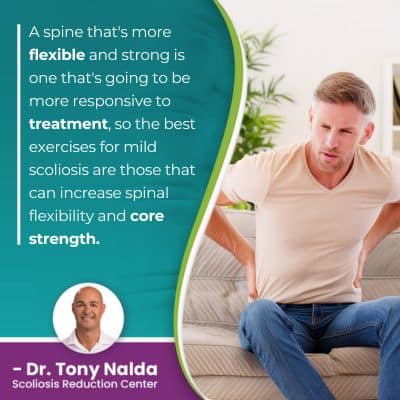What Are The Best Exercises For Mild Scoliosis? Explained!

No one form of treatment, exercise included, is enough to address scoliosis; the complex nature of the condition necessitates a customized treatment approach that involves combining the power of multiple treatment disciplines. Nonsurgical conservative scoliosis treatment values the role of exercise in keeping the spine strong and flexible, and its surrounding muscles strong, balanced, and supportive.
There was a time when the value of exercise as a facet of scoliosis treatment was undervalued, but we have since learned that the best exercises for mild scoliosis are scoliosis-specific exercises that are integrated into a proactive treatment plan.
Before getting to specific exercises that are good for mild scoliosis, let's talk about what makes one condition mild and another severe.
Table of Contents
Condition Severity
When scoliosis is first diagnosed, part of the process involves further classifying conditions based on key patient and condition variables.
Condition severity is a key piece of information that treatment plans are shaped around, and this is determined during X-ray with a measurement known as Cobb angle.
Determining a patient's Cobb angle involves drawing lines from the tops and bottoms of the curve's most-tilted vertebrae, and the resulting angle is expressed in degrees; the higher a Cobb angle, the more unnaturally tilted the spine is, and the more severe the condition.
Scoliosis ranges in severity from mild scoliosis to moderate scoliosis, severe and very severe scoliosis.
In addition to a rotational component, the curve has to be a minimum of 10 degrees to be diagnosed as scoliosis:
- Mild scoliosis is diagnosed with a Cobb angle of between 10 and 25 degrees
- Moderate scoliosis is diagnosed with Cobb angle measurements of between 25 and 40 degrees
- Severe scoliosis is diagnosed with Cobb angle measurements of 40+ degrees, and very-severe scoliosis is diagnosed at 80+ degrees
The important thing to understand about scoliosis is that it's a progressive condition, meaning its nature is to get worse over time, and this means the size of the unnatural spinal curve is going to increase, along with the condition's uneven forces, and their effects.
Before exploring treatment options, let's talk about how scoliosis affects the body.
Scoliosis Symptoms
No two scoliosis cases are the same.
Not only can scoliosis range in severity from mild to very severe, it can affect all ages, and there are also different types of scoliosis a person can develop.
Symptoms and treatment needs will depend on a number of patient/condition variables such as patient age, condition severity, type, and curvature location.
 The most prevalent type of scoliosis overall is adolescent idiopathic scoliosis, diagnosed between the ages of 10 and 18.
The most prevalent type of scoliosis overall is adolescent idiopathic scoliosis, diagnosed between the ages of 10 and 18.
While we don't know what causes most cases of scoliosis to develop initially, we do know what triggers its progression: growth.
As growth triggers progression, the more growth a patient has yet to go through, the more potential progression they face.
In children, the main scoliosis symptom is postural deviation, and this can involve uneven shoulders, uneven shoulder blades, a rib cage arch, an uneven waistline, and arms and legs that appear to have different lengths; additional signs can include changes to gait, balance, and coordination.
In adult scoliosis, the condition is compressive because skeletal maturity has been reached, so there is no lengthening motion of growth to counteract the unnatural spinal curve's compressive force.
It's compression of the spine and its surrounding muscles and nerves that causes the majority of condition-related pain, and it's back pain and/or pain that radiates into the extremities that is the main sign of scoliosis to bring adults in for a diagnosis and treatment.
What is Mild Scoliosis?
A diagnosis of mild scoliosis means an unnatural spinal curvature that rotates and has a Cobb angle of between 10 and 25 degrees.
A diagnosis of mild scoliosis means early detection has been achieved, and where a scoliosis is at the time of diagnosis doesn't mean that's where it will stay, so even scoliosis that's diagnosed as mild won't necessarily stay that way, particularly without treatment, or if not treated proactively.
There is a big difference between treating mild scoliosis and moderate and severe cases; the milder scoliosis is, the smaller the unnatural spinal curve is, and the simpler it is to treat.
If a diagnosis of mild scoliosis is responded to with a proactive treatment plan, there are fewer limits to what can be achieved, and treating scoliosis means addressing its underlying structural nature and increasing core strength.
When it comes to a conservative nonsurgical treatment approach, like the one patients of the Scoliosis Reduction Center benefit from, scoliosis exercises are an important part of treatment.
Exercises for Mild Scoliosis
In addition to condition-specific chiropractic treatment that works towards reducing the size of the scoliotic curve by realigning the spine, increasing core strength is a key facet of supporting the spine's structural changes.
Physical therapy and scoliosis exercises can help strengthen the spine's surrounding muscles so they can provide optimal support and stabilization for the spine.
A stronger core means less pressure on the individual structures of the spine to maintain the spine's neutral alignment and healthy curves.
A spine that's more flexible and strong is one that's going to be more responsive to treatment, so the best exercises for mild scoliosis are those that can increase spinal flexibility and core strength.
In addition, scoliosis-specific exercises/stretches can improve posture, muscular symmetry, and activate certain areas of the brain for improved brain-body communication.
The following exercises for scoliosis can help reduce pain while improving posture, strength, and flexibility.
Latissimus Dorsi Stretch
The latissimus dorsi stretch stretches one of the largest muscles of the back; this muscle is known to experience tightness caused by scoliosis.
Keeping the muscles that surround the spine as flexible and strong as possible offers pain relief and improved spinal support and stabilization.
The latissimus dorsi muscle shapes movement of the upper body, so keeping this muscle healthy can help with range of motion.
The latissimus dorsi stretch can be performed with these simple steps:
- Stand with the feet shoulder-width apart while keeping the knees bent slightly
- Stretch the arms straight overhead and grasp the left arm at the wrist with the right hand
- Bend towards the right until a stretch is felt in the trunk's opposite side (left side), and put most of the body's weight on the right leg
- Hold the position for 5 to 10 seconds and return to the starting position by pushing from the right foot
- Repeat on the opposite leg and side
The Seated Butterfly Stretch
 The Seated Butterfly stretch can loosen the hip flexors that are essential in balance, posture, and movement of the lower body.
The Seated Butterfly stretch can loosen the hip flexors that are essential in balance, posture, and movement of the lower body.
The Seated Butterfly stretch can help mild scoliosis patients improve their posture, balance, and stretch the muscles of the lower back, the thighs, hips, psoas, and the sartorius muscles.
Tight hip flexors can be painful and impact the lower body's range of movement, so keeping the hip flexors strong and loose will improve overall flexibility and range of motion.
In addition, as one of the earliest signs of scoliosis are uneven hips, this means that one hip is sitting higher than the other, and this means an uneven distribution of weight, so stretches that improve balance and posture can reduce the condition's asymmetrical effects.
The Seated butterfly stretch can be easily performed from home without the use of any equipment:
- Take a seated position
- Pull the legs into the body so the soles of the feet are touching
- Keep the spine in a straight line and engage the core
- Bend forward gently at the hips while exhaling
- Position the elbows gently on the thighs
- Be mindful of keeping the spine straight and hold the position for 15-30 seconds
The Pelvic Tilt
Pelvic tilts can be helpful for mild scoliosis patients by strengthening the stomach muscles, and core exercises also improve postural awareness.
Having good posture is important for spinal health, and the pelvic tilt can also help keep the lower back and body strong.
The proper technique for performing a pelvic tilt involves:
- Lie flat on the back
- Lift the legs and bend the knees with feet flat on the floor and toes pointing forward
- Pull in the belly button towards the spine; the pelvis will be lifted up while the back will flatten into the floor below
- Hold the position for 10 seconds and repeat in sets of 10
Conclusion
There are a number of ways that scoliosis exercises can augment corrective treatment results, and when combined with chiropractic treatment, physical therapy, corrective bracing, and rehabilitation, they can help with reducing pain, core strengthening, improving core stability, and spinal flexibility.
Exercises for scoliosis can also help facilitate good posture, balance, and coordination.
There are different approaches to scoliosis treatment that involve exercise from Schroth exercises as part of the Schroth method to SEAS (scientific exercise approach to scoliosis) and the use of scoliosis-specific exercises as part of physical therapy.
A corrective exercise specialist can help design an exercise-based approach to increasing core strength and stability so the spine is optimally supported and stabilized by strong surrounding muscles, and if/when a condition is impacted on a structural level in the form of a curvature reduction, core stabilization means more support for the structural changes.
Here at the Center, a diagnosis of mild scoliosis is going to be met with a proactive treatment plan that's started as close to the time of diagnosis as possible.
Dr. Tony Nalda
DOCTOR OF CHIROPRACTIC
After receiving an undergraduate degree in psychology and his Doctorate of Chiropractic from Life University, Dr. Nalda settled in Celebration, Florida and proceeded to build one of Central Florida’s most successful chiropractic clinics.
His experience with patients suffering from scoliosis, and the confusion and frustration they faced, led him to seek a specialty in scoliosis care. In 2006 he completed his Intensive Care Certification from CLEAR Institute, a leading scoliosis educational and certification center.
About Dr. Tony Nalda
 Ready to explore scoliosis treatment? Contact Us Now
Ready to explore scoliosis treatment? Contact Us Now





